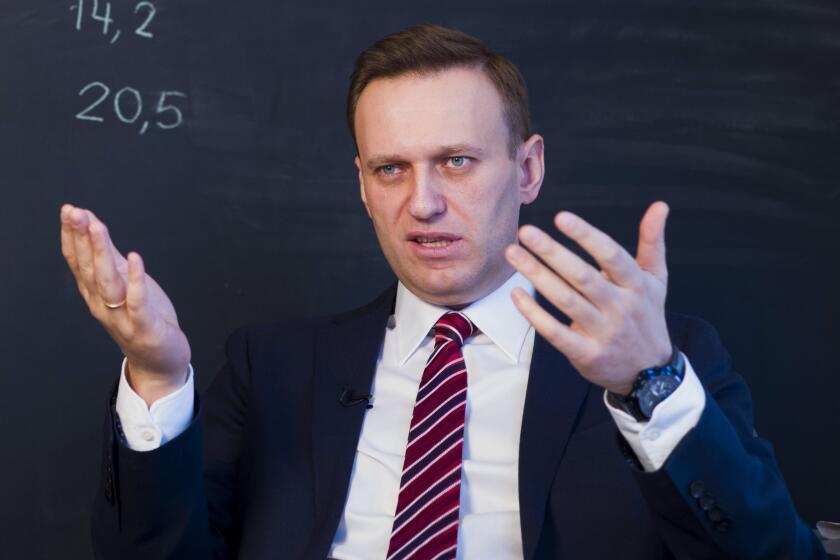Long-missing cleric inspires a massive rally in Lebanon
Thirty years ago, the charismatic black-turbaned cleric who launched modern Shiite Muslim politics in Lebanon mysteriously disappeared during a trip to Libya. But his legacy remains strong.
At a rally Sunday in this southern Lebanese town, tens of thousands of his movement’s followers demanded an answer to the Iranian-born Imam Moussa Sadr’s whereabouts. The rally capped a week of legal actions and political rhetoric that were meant in part to galvanize his political party, Amal, which has been eclipsed by the militant group Hezbollah as the leader of the country’s Shiite community.
Last week, Lebanese judicial authorities issued an arrest warrant for Libyan President Moammar Kadafi. Sadr had traveled to Libya with two companions in 1978, during a time of tension in Lebanon between Shiites and Palestinian militants backed by Kadafi and other Arab leaders.
“Again we say to the head of the Libyan regime Moammar Kadafi: The disappearance of Imam Moussa Sadr is your personal responsibility,” Nabih Berri, leader of the Amal movement and speaker of the Lebanese parliament, told flag-waving throngs of supporters. “What is required is to uncover the truth of the fate of Imam Sadr and his companions.”
Though a political partner of Hezbollah and its leader, Sheik Hassan Nasrallah, Amal has a relatively secular outlook and is closer to Syria than Iran, which is Hezbollah’s primary backer. Amal has been losing supporters, in contrast to the larger Hezbollah, which is perceived as more energetic and less corrupt.
“Amal, on the ground, it’s very weak compared to Hezbollah,” said Oussama Safa, an analyst at the Lebanese Center for Policy Studies, an independent think tank. “It has become kind of an open secret that it cannot grow or become strong under the current partnership with Hezbollah.”
Both Hezbollah and Amal count Sadr as a spiritual and political forebear. He was a member of the clerical family that includes Iraq’s Muqtada Sadr, and Moussa Sadr’s rise signaled the emergence of a new wave of Shiite political activism that transcended national boundaries.
An Iranian passport holder but of Arab descent, Sadr arrived in Lebanon in 1960 after finishing his studies in the Iranian seminary town of Qom. He was sent by Mohammed Reza Pahlavi, the shah of Iran, to minister to what was then Lebanon’s poorest community. He launched schools and clinics in the country’s south that served Christians and Sunni Muslims as well as Shiites and urged young clerics to be community leaders as well as scholars.
Vali Nasr, author of “The Shia Revival” and a professor of Middle East studies at Tufts University, likened Sadr’s ideas to the liberation theology practiced by radical Catholic priests in Latin America during the 1970s and 1980s. His movement demolished southern Lebanon’s traditional power structure, transferring political authority from the families of feudal landlords to clerics, and crystallized Shiite identity in the Arab world, which is dominated by the Sunni sect.
“The Shiites never reared their heads before Imam Moussa Sadr,” Nasr said in a phone conversation. “All the talk about Shiite rights in the Middle East, this all really began with Imam Moussa Sadr.”
He struggled to keep the country’s kaleidoscope of religious communities from descending into civil war, and withdrew from the organization he founded once it accepted backing from Syria. Southern Lebanon, the heartland of the Shiites, was becoming a base for Palestinian attacks against Israel
In 1978, Sadr made his fateful trip to Libya, perhaps to try to work out a deal between Sunni Arab leaders backing Palestinian leader Yasser Arafat and Lebanon’s Shiite community, which chafed under Palestinian domination.
Sadr, then 50, and his colleagues never made it home from Tripoli. Nasr said he was certain that they were killed by Libyan authorities to maintain Palestinian dominance in southern Lebanon.
“The killing of Moussa Sadr was like the assassination of Martin Luther King,” he said. “People who killed him did not like anyone who was arousing that community.”
But Sadr’s body was never found, and some Amal followers insist that he’s alive.
“He didn’t die,” said Zakaria, a 56-year-old pharmacist at Sunday’s rally who declined to give his last name. “He’s still in Libya in a jail.”
His disappearance seemed to only raise his stature, setting in motion a chain of events that would eventually spawn Hezbollah, which took over the Palestinian cause as its own.
One shopkeeper in Nabatiyeh pulled two journalists into his store to show a portrait of a smiling Sadr on display behind his cash register.
“Before Nasrallah, he was the leader of the resistance,” said Ali Ahmal, 40, pointing to the faded portrait. “He was bigger than Nasrallah.”
--
--
Special correspondent Raed Rafei in Beirut contributed to this report.
--
On latimes.com
Babylon & Beyond
For news, observations and links about the Middle East by Times correspondents, go to latimes.com/babylon.
More to Read
Start your day right
Sign up for Essential California for news, features and recommendations from the L.A. Times and beyond in your inbox six days a week.
You may occasionally receive promotional content from the Los Angeles Times.





